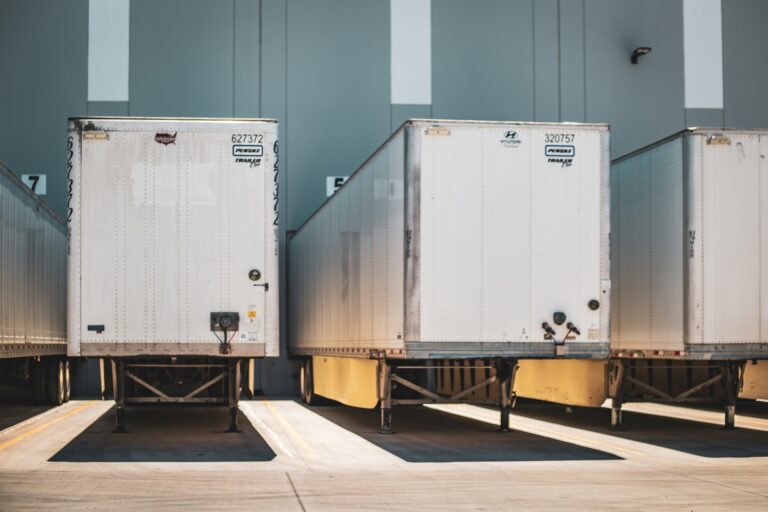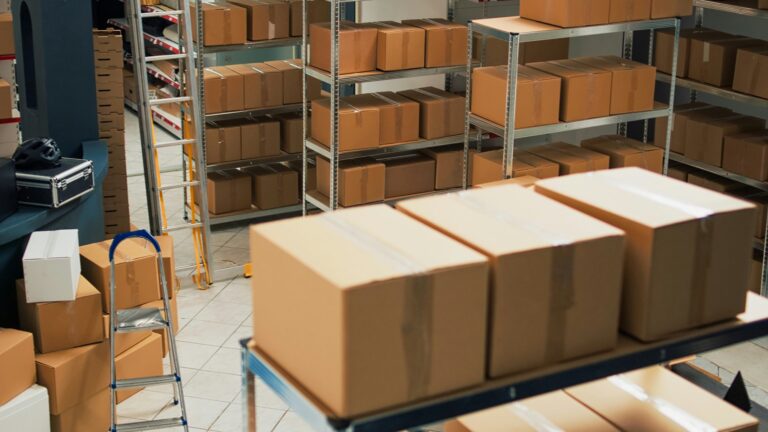Intermodal shipping services involve using multiple modes of transportation, such as trucks, trains, ships, and airplanes, to move freight. A key feature of intermodal shipping is the use of standardized containers, which allow cargo to be easily transferred between different transport modes without the need to unload or repack the goods. This approach enhances efficiency and flexibility, especially for long-distance or international shipments.
Key Features of Intermodal Shipping:
- Multiple Modes of Transport: Intermodal shipping utilizes different types of transportation, such as trucks, trains, ships, and even planes, to move goods. The shipment is transferred seamlessly between these modes, allowing for optimal use of each transport type.
- Standardized Containers: Intermodal shipping relies on standardized containers, such as shipping containers, which can be easily transferred between various modes of transportation (e.g., from a truck to a train). This standardization ensures compatibility and simplifies the process.
- Efficiency and Cost-Effectiveness: By combining multiple transport modes, intermodal shipping often reduces overall transit costs and time. Rail transport, for example, is more efficient for long-distance travel, while trucks handle the last-mile delivery, leading to lower shipping expenses.
- Flexibility and Scalability: Intermodal shipping offers flexibility, as it can handle a wide variety of cargo types and sizes. The system is scalable, allowing businesses to adjust their shipping volumes based on demand, using the most efficient routes and modes available.
- Reduced Handling: Since intermodal shipping uses standardized containers, goods are loaded once and remain in the same container throughout their journey. This reduces the need for multiple handling points, minimizing the risk of damage or loss.
- Environmental Benefits: Intermodal shipping is more environmentally friendly than relying solely on trucking. Trains, for example, are much more fuel-efficient than trucks for long-distance transport, reducing the carbon footprint of the shipment.
Benefits of Intermodal Shipping:
- Cost Savings: Intermodal shipping is often more cost-effective than relying on a single mode of transport, particularly when rail is used for long-distance hauls. The combination of different transport modes allows businesses to take advantage of lower costs for certain segments of the journey, reducing overall shipping expenses.
- Speed and Reliability: By using a combination of rail and truck, intermodal shipping can provide faster transit times than road-only transport, especially over long distances. Rail is often more reliable, with fewer delays compared to trucking, leading to more predictable delivery schedules.
- Greater Reach: Intermodal shipping extends the geographical reach of your shipments. It allows goods to be transported efficiently across long distances, including international shipping by combining rail, truck, and ocean transport. This expanded reach helps businesses serve broader markets.
- Reduced Risk of Damage and Theft: Since cargo is transported in standardized containers, the need for repeated handling is minimized. This reduces the risk of damage or theft, as goods remain in a sealed container throughout the journey, ensuring better protection.
- Increased Capacity: Intermodal shipping can increase the capacity of your supply chain by utilizing rail for long-haul shipments, which can carry larger volumes of freight. This is especially beneficial for high-volume or bulk shipments, allowing businesses to move more goods in one trip.
- Environmental Sustainability: Intermodal shipping is more environmentally friendly than relying solely on trucks. Rail, in particular, is much more fuel-efficient and produces fewer emissions per ton-mile compared to trucking. By reducing reliance on trucks, intermodal shipping helps lower the carbon footprint of transportation.
Types of Intermodal Shipping:
- Rail-to-Truck (Drayage): Goods are transported by rail for the majority of the journey and then transferred to trucks for final delivery. This is ideal for long-distance transport with last-mile delivery by truck.
- Truck-to-Rail: Goods are first moved by truck to a rail terminal and then shipped by rail for longer distances. This method combines the flexibility of trucking with the cost-efficiency of rail.
- Ocean-to-Rail: Used for international shipments, goods are first shipped by ocean freight to a port and then transferred to rail for inland delivery, optimizing cost and speed for global trade.
- Port-to-Store (Multimodal): This involves moving goods from a port directly to retail stores or distribution centers, typically using a combination of ocean and rail or truck transport for streamlined delivery.
- Air-to-Rail: For high-priority, time-sensitive goods, this method involves air transport for long-distance travel followed by rail for the final delivery, combining speed and cost-efficiency.
When to Choose Intermodal Shipping:
- Long-Distance or Cross-Country Shipments: When transporting goods over long distances or across the country, intermodal shipping offers significant advantages. Rail transport is particularly efficient for long hauls, reducing transportation time and cost compared to road transport alone.
- International Shipping: Intermodal shipping combines ocean freight for overseas travel with rail or truck for inland delivery, providing an efficient, cost-effective solution for cross-border shipments. This method streamlines the process, making it easier to handle long-distance, multi-country transport while optimizing both time and costs.
- Large or Bulky Cargo: For large or bulky shipments, intermodal shipping can be more efficient. Rail and truck can handle heavy or oversized cargo, allowing businesses to move larger volumes of goods with fewer logistical challenges compared to using only one mode of transport.
- Cost Sensitivity: If cost is a major concern, intermodal shipping can provide a more economical solution, particularly for long-distance shipments. Rail transport is typically cheaper than trucking over long distances, and combining it with trucks for final delivery can reduce overall shipping expenses.
- Environmental Considerations: Intermodal shipping is more environmentally friendly than relying solely on trucks, especially for long-distance transportation. Rail is more fuel-efficient and produces fewer emissions, making intermodal shipping a sustainable choice for businesses aiming to reduce their carbon footprint.
When Not to Choose Intermodal Shipping:
- Short Distances: For shipments over short distances, the benefits of intermodal shipping are diminished. It may be more efficient and cost-effective to use a single mode of transport, like trucking, for quicker delivery.
- Urgent or Time-Sensitive Shipments: If a shipment is time-sensitive, intermodal shipping may not be the best choice due to the potential delays from transferring cargo between different modes of transport. Expedited or direct shipping methods may offer faster delivery.
- Small Shipments: Intermodal shipping is generally more suitable for larger, bulk shipments. For small loads, it may be more practical to use less-than-truckload (LTL) or direct trucking services, which can be more cost-effective and simpler.
Intermodal shipping is a flexible and efficient freight solution that combines multiple modes of transportation, including trucks, trains, and ships, into one seamless process. By utilizing standardized containers, it minimizes handling, improves security, and enhances cost-effectiveness for long-distance and international shipments. This method is especially beneficial for large or bulky cargo and for shipments that need to travel across continents, offering businesses a sustainable, cost-efficient, and adaptable way to manage their supply chain logistics.
Intermodal Shipping Services refer to a transportation method that uses multiple modes of transportation (such as trucks, trains, ships, and sometimes airplanes) to move freight. The key feature of intermodal shipping is that the cargo is transported in standardized containers that can be easily transferred between different modes of transport without having to unload or repack the goods. This makes the process more efficient and flexible, particularly for long-distance or international shipping.
Key Features of Intermodal Shipping:
Multiple Modes of Transport: Intermodal shipping combines at least two different modes of transportation—typically rail, truck, and ocean freight. For example, a shipment might be moved by rail from one city to a port, and then by ship across the ocean, with trucks being used for last-mile delivery to the final destination.
Standardized Containers: Intermodal shipping relies on standardized containers (often 20 or 40 feet in length) that can be easily loaded and unloaded across various transportation modes. This containerization allows for efficient handling at each stage of the journey, reducing the risk of damage and the need for repacking.
Efficiency and Cost-Effectiveness: By leveraging different modes of transport, intermodal shipping can take advantage of the strengths of each. Rail, for instance, is often more fuel-efficient for long hauls, while trucks can provide door-to-door service for the final delivery. This combined approach can be more cost-effective, especially for long-distance or heavy freight.
Flexibility and Scalability: Intermodal shipping allows for greater flexibility in routing and scheduling. Different modes of transport can be selected based on the specific needs of the shipment, such as speed, cost, or distance. This makes intermodal a versatile option for a wide range of cargo types.
Reduced Handling: Because the same container is used throughout the journey, there’s less need for unloading and reloading the freight. This streamlined handling reduces the risk of damage, loss, or theft and improves overall security and safety.
Environmental Benefits: Rail is often a more environmentally friendly mode of transport compared to trucks, due to its lower carbon emissions per ton-mile. By integrating rail into the shipping process, intermodal shipping can reduce the overall environmental impact of transportation.
Benefits of Intermodal Shipping:
Cost Savings: Combining rail (which is cheaper for long-distance freight) with trucking (which is more efficient for short-haul delivery) can result in cost savings compared to relying on trucks alone for the entire journey. Intermodal shipping allows companies to optimize their transportation costs.
Speed and Reliability: For longer distances, intermodal shipping can be faster than relying on a single mode like trucking, particularly when rail provides a more direct or efficient route. Additionally, intermodal shipments are often more reliable due to fewer interruptions, as rail schedules tend to be more predictable than truck delivery.
Greater Reach: Intermodal shipping offers a wider network of routes, particularly for international shipments. It allows goods to be moved across different regions, countries, or even continents seamlessly, without having to transfer the cargo between different types of containers.
Reduced Risk of Damage and Theft: With fewer transfers between different modes of transport, there is less risk of cargo being damaged, lost, or stolen. The use of secure, standardized containers also helps to protect the freight during its journey.
Increased Capacity: Rail transport can handle larger volumes of cargo, which can be beneficial for businesses shipping large quantities of goods. This allows companies to benefit from economies of scale in transporting goods over long distances.
Environmental Sustainability: By using rail for long-haul transport, which is more energy-efficient and emits fewer greenhouse gases than trucking, intermodal shipping can help companies reduce their carbon footprint. This makes it a more sustainable option compared to relying solely on trucks.
Types of Intermodal Shipping:
Rail-to-Truck (Drayage): Often used for long-distance transportation. Goods are shipped by rail over long distances and then transferred to a truck for local delivery. The transfer point is usually a rail terminal or yard.
Truck-to-Rail: This involves transporting goods by truck to a rail terminal, then transferring them to railcars for the longer leg of the journey. This is often used for cross-country shipping, especially for bulky or heavy cargo.
Ocean-to-Rail: This is a common method for international shipping, where goods are shipped by ocean freight to a port and then transferred to rail for inland transport. Once they arrive at a rail terminal, they can be offloaded and sent to the final destination by truck.
Port-to-Store (Multimodal): A combination of ocean, rail, and truck transport, where containers are moved from an international port via rail, then trucked to distribution centers or retail stores. This type of service is often used for imports and exports.
Air-to-Rail: For time-sensitive shipments, air freight may be used to transport goods over long distances quickly, and then rail is used for the final leg of the journey.
When to Choose Intermodal Shipping:
- Long-Distance or Cross-Country Shipments: Intermodal shipping is ideal for freight that needs to cover large distances, especially when rail can provide a more efficient and cost-effective means of transport than trucking.
International Shipping: For goods that need to be shipped across oceans and then transported inland, intermodal is commonly used to connect ports to final destinations, especially for containers that can be transferred between ocean carriers and railroads. - Large or Bulky Cargo: Intermodal shipping works well for heavy or oversized items that are not suited to smaller trucks but can be easily handled in standardized shipping containers.
- Cost Sensitivity: For businesses looking to reduce transportation costs over long distances, intermodal shipping can provide a more affordable alternative to relying on trucks alone for the entire journey.
- Environmental Considerations: If reducing carbon emissions and improving sustainability is a priority, intermodal shipping, especially with the use of rail, can offer a greener alternative compared to all-truck transportation.
When Not to Choose Intermodal Shipping:
- Short Distances: If the shipment is relatively small or covers a short distance, intermodal shipping may not be as efficient or cost-effective as relying on trucking alone.
- Urgent or Time-Sensitive Shipments: Intermodal shipping involves multiple handoffs between modes, which can introduce delays. If speed is a critical factor, a more direct mode of transport (such as trucking or air freight) may be preferred.
- Small Shipments: For very small or light shipments, especially if they don’t fill a standard container, intermodal may not be the most efficient option due to the need to handle full containers.
Intermodal Shipping is a versatile and efficient freight transport solution that integrates multiple modes of transportation—such as trucks, trains, and ships—into a single seamless process. By using standardized containers, intermodal shipping reduces handling, enhances security, and improves cost-effectiveness for long-distance and international shipments. It is particularly beneficial for large, bulky shipments, or those that need to be moved across continents, offering businesses a flexible, sustainable, and cost-efficient way to manage their supply chain logistics.



